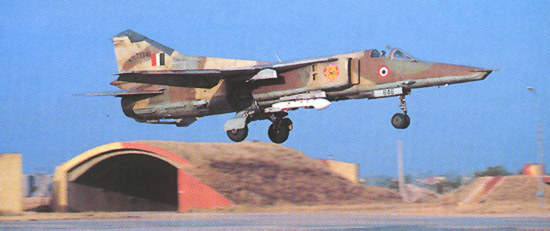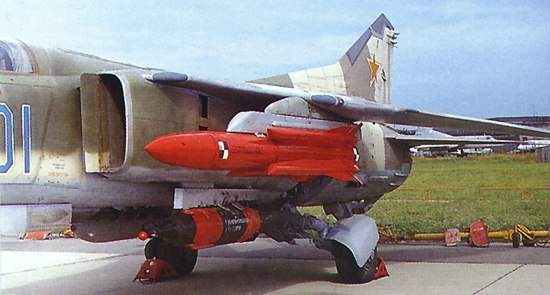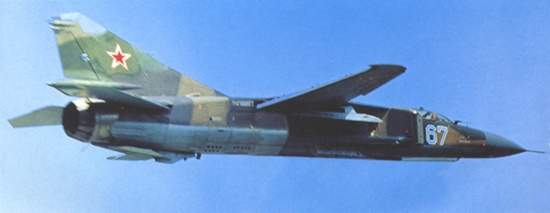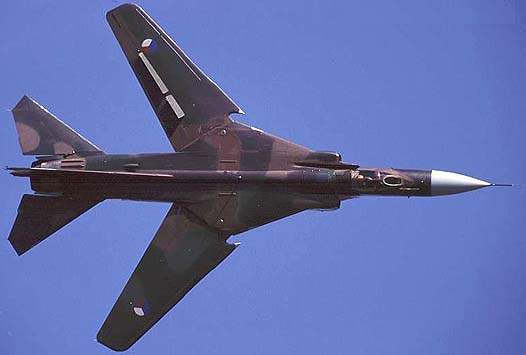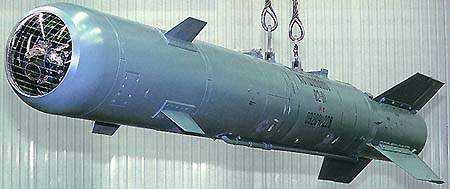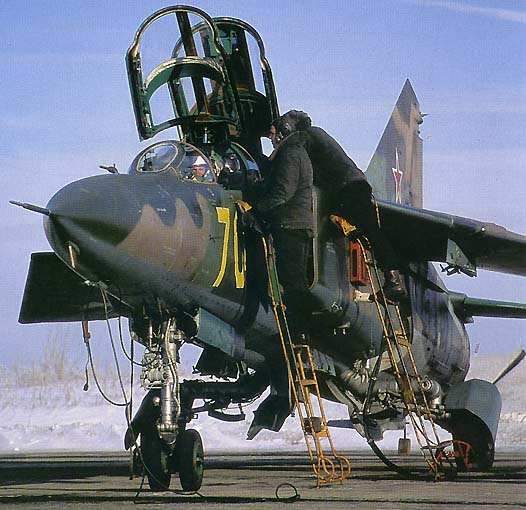The MiG-27K fighter bomber aircraft is a ground-attack variant of the MiG-23 fighter and manufactured by RSK MiG and the Irkutsk Aircraft Production Association Joint Stock Company. Both the MiG-23 fighter aircraft and the MiG-27 fighter bomber aircraft are sometimes referred to by the NATO codename Flogger.
The MiG-27 entered service with the Soviet Union air force in 1975 and its maiden flight took place in August 1970. The aircraft is no longer in service with Russia, but remains in service with India (117 aircraft) and Sri Lanka (seven).
The MiG-27K variant of the MiG-27 family is a variable geometry wing fighter bomber. The primary mission of the aircraft is the destruction of moving and stationary, fixed and mobile ground targets including hardened targets.
In February 2010 a MiG-27 crashed at Siliguri Village, West Bengal, due to defects in its R29 engines.
Missiles on the MiG-27K
The aircraft carries three types of air-to-surface missile. The Kh-23M air-to-surface missile (NATO codename AS-7 Kerry) is supplied by the Zvezda-Strela State Research and Production Centre, Moscow.
The Kh-25ML (NATO designation AS-12 Kegler), also supplied by Zvezda, has semi-active laser guidance and the range is between 2.5km and 10km. The missile is equipped with a high-explosive (HE) 86kg warhead.
The Kh-29ML (NATO designation AS-14 Kedge), built by Vympel, uses semi-active laser guidance and has a range up to 10km. The missile is equipped with a 317kg penetrating warhead.
The anti-radar missile is the Zvezda Kh-27PS (NATO designation AS-12 Kegler).
The air-to-air missile carried on the MiG-27K is the R-60M (NATO designation AA-8 Aphid) supplied by Vympel. The missile has the capability to engage targets manoeuvring at an acceleration up to 12g. The R-60M has a range of target designation angles to ±20° and an infrared homing head with photodetector cooling.
Ordnance
The MiG-27K can carry the KAB-500L laser-guided bomb and KAB-500KR television-guided bomb, which are supplied by the Region State Research and Production Enterprise in Moscow.
The KAB-500L has semi-active laser homing and is armed with a 380kg high-explosive warhead.
The KAB-500KR television-guided bomb operates on the ‘drop and forget’ principle. Target lock-on for a parked aircraft is achieved at a range of 15-17km in visibility of 10km.
The warhead can pierce a reinforced concrete barrier up to 1.5m thick.
The aircraft can also carry S-24, S-25, S-8, S5 unguided rockets, and a range of aerial bombs up to 500kg size, cluster bombs and incendiary devices.
Guns
The aircraft has a built-in 30mm Sh-6-30 gun with 260 rounds of ammunition. The gun, supplied by the Instrument Design Bureau, based in Tula, fires HEFI rounds and AO-18 cartridges.
The Sh-6-30’s maximum fire rate is 5,000 rounds a minute and its muzzle velocity is 850m per second.
The aircraft is also equipped with an SPPU-22 two-barrel, 23mm gun pod with 200 rounds of ammunition. The SPPU-22 pod houses a GSh-23 aircraft gun.
The maximum fire rate is 3,000 rounds a minute and the muzzle velocity is 715m per second.
Countermeasures
The MiG-27K aircraft is equipped with a modern electronic countermeasures suite, including a new passive jamming system.
MiG-27K avionics
The MiG-27K is equipped with the PrNK-23K integrated navigation and aiming system, which consists of an Orbita-20-23K digital computer, an optical television indicator and a Kaira-1 laser and television sighting system for KAB-500L and KAB-500KR guided aerial bombs. The target lock-on range is 7km-8km.
The KN-23 navigation system installed on the MiG-27K incorporates a Radical navigation system in place of the RSBN-6s short-range radio navigation system.
The MiG-27K does not carry any airborne radar.
The radio-command systems installed on the MiG-27K are the Delta-NM and the Viyuga anti-radar missile control system for the Kh-27PS missile, which is installed in an externally mounted pod.
Engine
The MiG-27Kis powered by a Khatchaturov R-29B-300 afterburning turbojet engine, which produces 78.5kN of dry thurst. Its thrust afterburner is 112.8kN. The aircraft can carry up to four PTBB-800 external fuel tanks.
Performance
The MiG-27K can climb at a rate of 200m per second. The maximum and cruise speed of the aircraft are 1,800km per hour and 1,250km per hour, respectively. Its maximum range is 2,100km.
The combat radius and ferry range of the aircraft are 780km and 2,500km respectively. Its service ceiling is 14,000m.
The aircraft weighs 11,908kg and its maximum take-off weight is 20,670kg.

